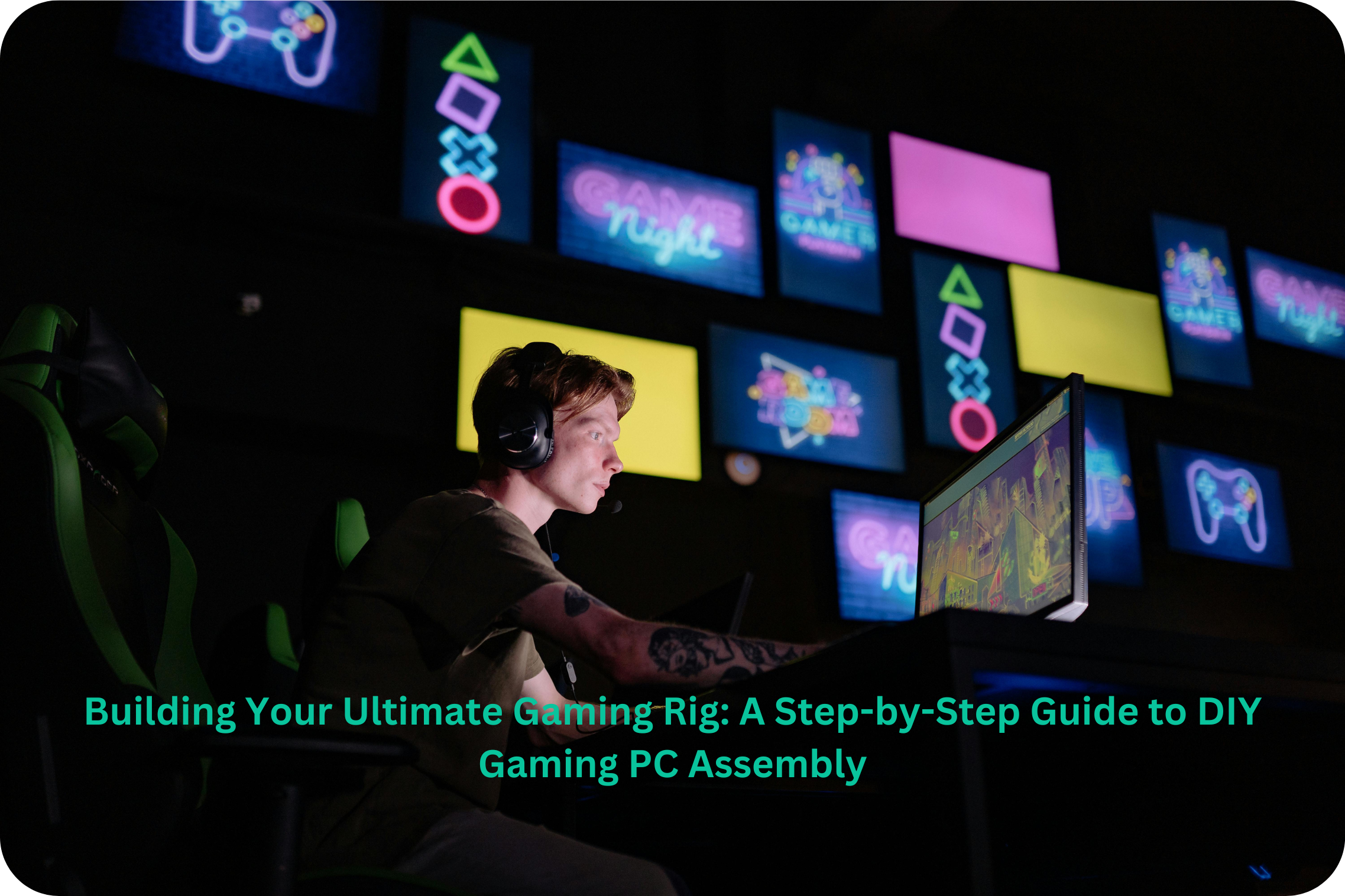Welcome to our comprehensive guide on building your own gaming PC from scratch! If you’re a passionate gamer looking to upgrade your gaming experience, or simply want to save some cash by building your own custom gaming rig, you’ve come to the right place. In this article, we’ll walk you through the step-by-step process of assembling your DIY gaming PC, ensuring you have all the necessary components, understanding compatibility, and optimizing performance. So, let’s dive in and unleash your gaming potential!
Choosing the Right Components
When it comes to building a gaming PC, selecting the right components is crucial for optimal performance and compatibility. Let’s break down the key components you’ll need:
1. Processor (CPU)
The processor acts as the brain of your gaming PC, handling all the calculations and tasks. Look for a processor that offers high clock speeds and multiple cores for smooth gameplay.
2. Graphics Card (GPU)
The graphics card is responsible for rendering and displaying visuals on your monitor. Invest in a powerful GPU with ample VRAM to ensure crisp graphics and smooth frame rates.
3. Motherboard
The motherboard serves as the central hub connecting all your components. Choose a motherboard that supports the socket type of your chosen CPU and has sufficient slots for expansion.
4. Memory (RAM)
RAM allows your PC to run multiple tasks simultaneously. Aim for at least 8GB of RAM, but for a more future-proof build, consider 16GB or even 32GB.
5. Storage
For storage, opt for a solid-state drive (SSD) for faster boot times and game loading, paired with a larger hard disk drive (HDD) for ample storage space.
6. Power Supply Unit (PSU)
The PSU provides power to all your components. Ensure it has sufficient wattage to handle your setup and is from a reputable brand to avoid any power-related issues.
7. Cooling System
Prevent overheating by installing an efficient cooling system. Consider a combination of fans, heat sinks, and liquid cooling solutions for optimal temperature control.
Now that you have a clear understanding of the essential components, you’re ready to move on to the next step: assembling your gaming PC.
Assembling Your DIY Gaming PC
Now that you have all the necessary components, it’s time to put them together and bring your gaming PC to life. Follow these steps for a successful assembly:
1. Prepare your workspace
Find a clean, well-lit area to work in. Ensure you have all the necessary tools, such as screwdrivers, cable ties, and thermal paste, within reach.
2. Install the CPU
Carefully remove the CPU from its packaging and align it with the socket on the motherboard. Gently lower it into place and secure it according to the manufacturer’s instructions.
3. Install the CPU cooler
If your CPU cooler requires assembly, follow the instructions provided. Apply a pea-sized amount of thermal paste on the CPU, then attach the cooler, ensuring it is securely fastened.
4. Install RAM modules
Insert the RAM sticks into the appropriate slots on the motherboard. Apply gentle pressure until they click into place. Refer to your motherboard manual for guidance on proper installation.
5. Mount the motherboard
Position the motherboard in the case, aligning the screw holes. Use the provided screws to secure it, being careful not to overtighten. Connect the necessary power cables and data cables.
6. Install storage drives
Mount your SSD and HDD in the designated slots, using screws or brackets provided. Connect the necessary cables to the motherboard and power supply.
7. Install the graphics card
Align the graphics card with the appropriate slot on the motherboard and firmly press it down until it clicks into place. Secure it with screws and connect the necessary power cables.
8. Connect peripherals
Attach your monitor, keyboard, mouse, and other peripherals to the appropriate ports on the back of the case.
9. Power up and test
Connect the power supply to the motherboard and other components. Double-check all connections before powering up your PC. If everything is properly connected, press the power button and ensure all fans and lights turn on.
Congratulations! You have successfully assembled your DIY gaming PC. In the next section, we’ll guide you through the installation of the operating system and essential drivers.
Operating System Installation and Driver Setup
Now that your DIY gaming PC is assembled, it’s time to install the operating system (OS) and set up the necessary drivers. Follow these steps:
1. Choose your operating system
Decide on the operating system you want to install, whether it’s Windows, macOS, or a Linux distribution. Ensure you have a bootable installation media, such as a USB drive or DVD.
2. Install the operating system
Boot your PC from the installation media. Follow the instructions provided by the OS installer, selecting your preferred language, region, and customizing any settings as needed.
3. Update the OS
Once the installation is complete, connect your PC to the internet and check for any available updates. Install the latest updates to ensure your OS is up to date with the latest security patches and features.
4. Install essential drivers
Visit the website of your motherboard manufacturer and download the latest drivers for your specific model. Install the chipset, LAN, audio, and other necessary drivers to ensure proper functionality.
5. Graphics card drivers
For optimal gaming performance, visit the website of your graphics card manufacturer (e.g., NVIDIA or AMD) and download the latest drivers for your specific GPU model. Install the drivers and any associated software.
6. Additional drivers and software
Check for any other drivers or software required for your specific components, such as your keyboard, mouse, or peripherals. Visit the manufacturer’s website to download and install the appropriate drivers or software.
7. Test and optimize
Restart your PC and ensure all the drivers are functioning correctly. Adjust any necessary settings, such as display resolution or audio preferences, to optimize your gaming experience.
With your operating system installed and drivers set up, your DIY gaming PC is ready to deliver an immersive gaming experience. In the next section, we’ll explore essential tips for maintaining and upgrading your system.
Maintaining and Upgrading Your DIY Gaming PC
Once you have built your DIY gaming PC, it’s important to maintain and upgrade it periodically to ensure optimal performance and longevity. Here are some essential tips:
1. Regularly clean your PC
Dust and debris can accumulate over time, affecting your PC’s cooling efficiency. Use compressed air or a soft brush to clean the fans, vents, and other components to prevent overheating.
2. Update software and drivers
Regularly check for updates for your operating system, drivers, and gaming software. Keeping everything up to date ensures compatibility, security, and access to the latest features and optimizations.
3. Monitor temperatures
Use monitoring software to keep an eye on your PC’s temperatures. High temperatures can lead to performance issues and potential damage. Adjust fan speeds or consider additional cooling if necessary.
4. Optimize storage
Regularly clean up your storage drives by removing unnecessary files and programs. Consider moving large games or files to an external drive to free up space and improve overall system performance.
5. Upgrade components as needed
As technology advances, you may want to upgrade specific components to keep up with demanding games. Consider upgrading your graphics card, adding more RAM, or increasing storage capacity when necessary.
6. Backup your data
Set up regular backups of your important files and game saves. This ensures that in the event of hardware failure or other issues, you won’t lose your valuable data.
7. Consult forums and communities
Engage with online gaming and PC building communities to stay up to date with the latest trends, troubleshooting tips, and upgrade recommendations. Forums and social media groups can be invaluable resources.
By following these maintenance and upgrade tips, you’ll be able to enjoy your DIY gaming PC for years to come. In the final section, we’ll summarize the key points and offer some closing thoughts.
Conclusion: Unleash Your Gaming Potential with a DIY Gaming PC
Congratulations on completing your DIY gaming PC! By building your own gaming rig, you have not only saved money but also gained the satisfaction of customizing your system to meet your specific gaming needs. Let’s recap the key points:
Choose the right components
Ensure you select components that offer high performance, compatibility, and future-proofing. Consider factors like the processor, graphics card, motherboard, memory, storage, power supply, and cooling system.
Assemble with care
Take your time and follow the assembly steps carefully. Prepare your workspace, install the CPU and cooler, mount the motherboard, connect storage drives, install the graphics card, and connect peripherals.
Install the operating system and drivers
Choose your preferred operating system, install it, and update it with the latest patches. Install essential drivers for your motherboard, graphics card, and other components to ensure optimal performance.
Maintain and upgrade regularly
Keep your DIY gaming PC clean and free of dust, update software and drivers, monitor temperatures, optimize storage, and consider upgrading components as needed to keep up with demanding games.
Building and maintaining your own DIY gaming PC not only provides you with a powerful gaming platform but also gives you a deeper understanding of your system. Don’t forget to have fun and explore the vast world of gaming that awaits you. Enjoy your gaming adventures and may your new gaming rig always deliver exceptional performance!
In conclusion, building a DIY gaming PC is an exciting and rewarding endeavor. By carefully selecting the right components, assembling them with precision, and maintaining and upgrading your system regularly, you can create a powerful gaming rig that meets your specific needs. Not only does this approach save you money, but it also allows for customization and future-proofing. Remember to stay informed about the latest trends and seek advice from online communities when needed. So, unleash your gaming potential and embark on a thrilling gaming journey with your very own DIY gaming PC. Happy gaming!

